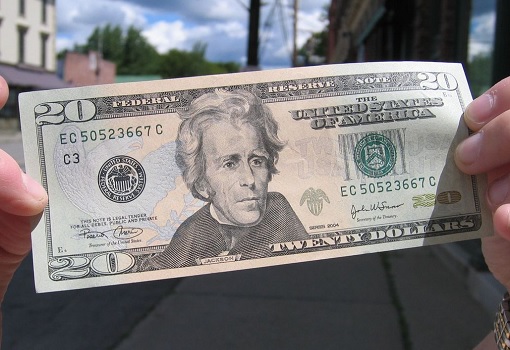Born a slave in Maryland, Harriet Tubman was beaten and whipped by her various masters as a child. But 194 years after she was born and tortured, Tubman (born Araminta Ross; 1822 – March 10, 1913) is to become first African-American on U.S. currency. And she’s going to replace former President Andrew Jackson, a slave owner.
The U.S. Treasury Department said on Wednesday that Tubman would take the centre spot on the bill, while Jackson would move to the back. Treasury Secretary Jack Lew explained the redesign gives the Treasury “a chance to open the aperture to reflect more of America’s history.”

Along with $5 and $10 new notes, the new designs should be unveiled by 2020 and go into circulation “as quickly as possible”, with the $10 bill scheduled to go out first. Mr Lew made a U-turn on his commitment last year to make a woman the face of the new $10 bill, opting instead to keep Alexander Hamilton, after he was overwhelmed by the first U.S. Treasury secretary’s fans.
Andrew Jackson was the seventh President of the United States – from 1829 to 1839 – and a hero of the War of 1812’s Battle of New Orleans, where he defeated the main British invasion army. But he has been criticized for having signed the Indian Removal Act, which relocated a number of native tribes in the South to Indian Territory (now Oklahoma).

Besides his mistreatment of American Indians, Jackson also owned hundreds of slaves who worked on the Hermitage plantation, a 640-acre (259 ha) plantation in Davidson County, near Nashville. His plantation empire grew to 1,050 acres (425 ha). Starting with 9 slaves, he was said to own as many as 300 slaves at one time.
The African-American slaves worked on his cotton plantation, enriching Jackson in the process. He permitted slaves to be whipped to increase productivity but he was considered a humane slave owner because he furnished his slaves food and housing, and did not prohibit his female slaves from having children.

However, it was the opposite for Harriet Tubman. Born into slavery, Tubman escaped to Philadelphia only to return to Maryland and subsequently made some 13 missions over 11 years to rescue approximately 70 enslaved families and friends. Also called “Moses”, Tubman smuggled slaves to safety via the Underground Railroad, without losing a single of them.
Her actions sent shivers down slave owners’ spine. Anxious and angry, slave owners posted rewards for her capture. After the Fugitive Slave Act of 1850 was passed, she helped guide fugitives farther north into Canada, and helped newly freed slaves find work. But her talents didn’t stop there. Tubman worked for the Union Army as a cook, nurse and even a spy when the Civil War began.

Tubman was also the country’s first woman to lead an armed expedition in the war. She guided the raid at Combahee Ferry which liberated more than 700 slaves. After she died in 1913, she became an icon of American courage and freedom. But she died penniless because her endless contributions to others had left her in poverty.
A survey at the end of the 20th century named her as one of the most famous civilians in American history before the Civil War, third only to Betsy Ross and Paul Revere. Dozens of schools, statues, stamps were named and created in her honour. In March 2013, President Barack Obama signed a proclamation creating Harriet Tubman Underground Railroad National Monument on the Eastern Shore.

While Alexander Hamilton would remain on the $10, and Abraham Lincoln on the $5, the Treasury has decided to add images of women to the back of both currency notes. A new $10 bill will add images of five female leaders of the women’s suffrage movement – Lucretia Mott, Sojourner Truth, Susan B Anthony, Elizabeth Cady Stanton, and Alice Paul.
As for the new $5 note, the reverse of the currency will show former first lady Eleanor Roosevelt, Marian Anderson and civil rights leader Martin Luther King Jr. The women last depicted on US bills were former first lady Martha Washington, on the $1 silver certificate from 1891 to 1896, and Native American Pocahontas, in a group photo on the $20 bill from 1865 to 1869.

Still, the new $20 currency will definitely carry the best story about the history of slavery in America. The choice of the freed slave and freedom fighter Harriet Tubman to decorate the $20 note is an exciting decision. As for Andrew Jackson, he actually hated paper currency and had vetoed the re-authorization of the Second Bank of the United States. So, he should thank his lucky star to be still featured on currency note.
Other Articles That May Interest You …
- Berkshire Annual Letter – Billionaire Buffett Reveals 7 Important Messages
- Soros – We’re About To See Something That Hasn’t Happened in “80 Years”
- Woman On $10 Dollar Notes? Here’re 20 Countries That Have Already Done That
- Cashless Societies – Do You Really Want To Create Such Monsters?
- Exposed!! – How HSBC Swiss Bank Helped Hide (Dirty) Money
- Take A Look At Norway’s New Notes – The World’s Best Money Ever Designed
- Here’s What $100 Is Actually Worth In Each State Of America
- Here’re 11 Amazing Hidden Messages On Dollar Bills
- Debts & Deficits – 21 Currencies That Have Gone Bust

|
|
April 21st, 2016 by financetwitter
|


|

|

|

|

|

|




























Comments
Add your comment now.
Leave a Reply